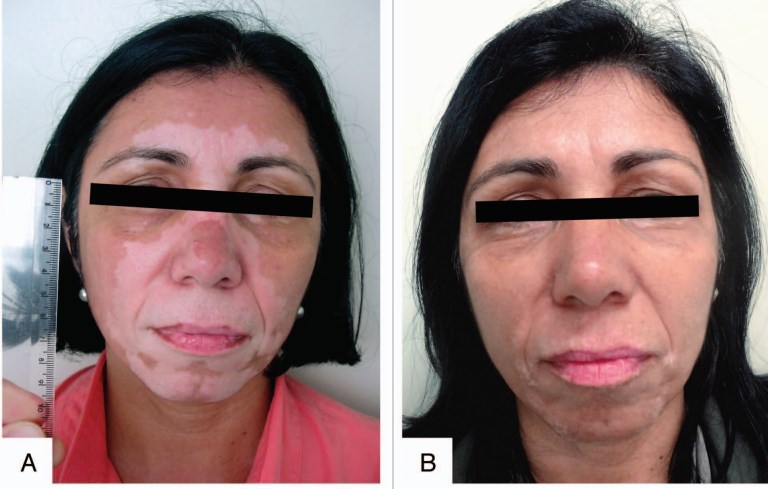Spotty skin coloring (vitiligo) treated by augmenting topical tacrolimus with oral Vitamin D
Vitamin D status and the effects of oral vitamin D treatment in children with vitiligo: A prospective study.
Clin Nutr ESPEN. 2016 Oct;15:28-31. doi: 10.1016/j.clnesp.2016.05.006. Epub 2016 Jun 9.
Karagüzel G1, Sakarya NP2, Bahadır S3, Yaman S4, Ökten A5.
 Vitiligo and Vitamin D Receptor
* Vitiligo (spotty skin coloring) is 4 X more likely if poor Vitamin D Receptor – meta-analysis July 2018
* Vitamin D Receptor in vitiligo skin activated by UVB – May 2018
The risk of 41 diseases at least double with poor Vitamin D Receptor as of July 2019
Items in both categories Autoimmune and Vitamin D Receptor are listed here:
{category}
Items in both categories Autoimmune and Skin are listed here:
{category}
1. See also web
* https://en.wikipedia.org/wiki/Tacrolimus
* Use of Tacrolimus Ointment in Vitiligo Alone or in Combination Therapy 2009
* "Current treatments for vitiligo are largely unsatisfactory. Topical corticosteroids and phototherapy (narrow-band UVB and psoralen+UVA) are the most prescribed, however, these therapies are often not effective and have important side-effect, especially when used for a long time. Many studies have reported the efficacy and safety of tacrolimus ointment in adults and children with vitiligo, particularly when located on the head and neck. Successful treatment is possible when it is combined with other therapies, such as narrow-band UVB, microphototherapy, helium-neon laser, or narrow-band excimer laser."
* [How I help people understand vitiligo](https://www.ted.com/talks/lee_thomas_how_i_help_people_understand_vitiligo?utm_source=newsletter_daily&utm;_campaign=daily&utm;_medium=email&utm;_content=button__2019-08-29#t-176311) TedTalk Video NYC TV News anchor
* Learned how to react positivily. Is now is a spokesman for the problem https://leethomas.com/
*
Vitiligo and Vitamin D Receptor
* Vitiligo (spotty skin coloring) is 4 X more likely if poor Vitamin D Receptor – meta-analysis July 2018
* Vitamin D Receptor in vitiligo skin activated by UVB – May 2018
The risk of 41 diseases at least double with poor Vitamin D Receptor as of July 2019
Items in both categories Autoimmune and Vitamin D Receptor are listed here:
{category}
Items in both categories Autoimmune and Skin are listed here:
{category}
1. See also web
* https://en.wikipedia.org/wiki/Tacrolimus
* Use of Tacrolimus Ointment in Vitiligo Alone or in Combination Therapy 2009
* "Current treatments for vitiligo are largely unsatisfactory. Topical corticosteroids and phototherapy (narrow-band UVB and psoralen+UVA) are the most prescribed, however, these therapies are often not effective and have important side-effect, especially when used for a long time. Many studies have reported the efficacy and safety of tacrolimus ointment in adults and children with vitiligo, particularly when located on the head and neck. Successful treatment is possible when it is combined with other therapies, such as narrow-band UVB, microphototherapy, helium-neon laser, or narrow-band excimer laser."
* [How I help people understand vitiligo](https://www.ted.com/talks/lee_thomas_how_i_help_people_understand_vitiligo?utm_source=newsletter_daily&utm;_campaign=daily&utm;_medium=email&utm;_content=button__2019-08-29#t-176311) TedTalk Video NYC TV News anchor
* Learned how to react positivily. Is now is a spokesman for the problem https://leethomas.com/
* 
BACKGROUND & AIMS:
Vitiligo is a pigmentary disorder and autoimmune pathogenesis seems most likely. Decreased vitamin D levels have been related to several autoimmune diseases. Little is known about the association of vitiligo and vitamin D. We aimed to evaluate serum 25-hydroxyvitamin D [25(OH)D] levels in children with vitiligo and to determine the efficacy of oral vitamin D therapy on the repigmentation of vitamin D deficient patients.
METHODS:
Thirty patients aged 6-17 years with vitiligo and 30 sex- and age-matched apparently healthy controls were included in this prospective study. Size of the vitiligo representative area was estimated using the point counting method and blood samples were obtained at the beginning and month six. By the end of the study, all patients treated with topical tacrolimus for six months and the patients who were vitamin D deficient (n = 14) had been on combination treatment of oral vitamin D and topical tacrolimus. A dose of 1500 IU/day vitamin D was given if the serum 25(OH)D levels <20 ng/ml and 3000 IU/day was given if the levels <10 ng/ml for six months. Serum 25(OH)D levels were measured by high-performance liquid chromatography.
RESULTS:
Serum 25(OH)D levels of patients and controls were not significantly different (p > 0.05). Lesion size decreased from 66.1 ± 58.3 cm2 to 48.0 ± 52.6 cm2 after six months of treatment in patients who received combination treatment (p < 0.001) and increased in patients who received only topical therapy from 34.8 ± 48.1 cm2 to 53.5 ± 64.9 cm2 (p < 0.01).
CONCLUSIONS:
Although we did not determine decreased serum 25(OH)D levels in children with vitiligo, we showed that combination treatment with oral vitamin D and topical tacrolimus is more effective in reaching repigmentation than topical tacrolimus alone. Oral vitamin D supplementation might be useful for children with vitiligo who are also deficient in vitamin D.
PMID: 28531780 DOI: 10.1016/j.clnesp.2016.05.006
